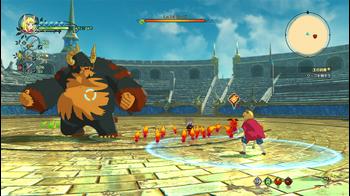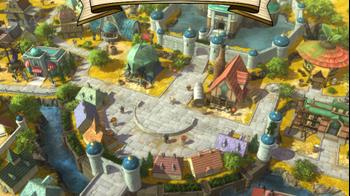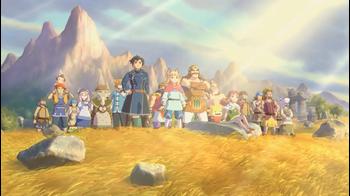Ni no Kuni II: Revenant Kingdom Review
I am not hesitant to say I was and still am a huge fan of the original Ni no Kuni. Released back in 2013, it was one of those titles that caught social media by storm. Even acquaintances of mine who typically didn't play Japanese RPGs were talking about this game.
In many ways, it reminded me of my youth as a student: coming home from summer break, laying down on the couch, and spending months on end whisked away to a fantasy land, helping me to forget about whatever troubles I was currently experiencing.
Despite it being their first co-developed title, Studio Ghibli was able to accomplish so much with Level-5 with their decades of experience capturing the imaginations of children and adults the world over. And while Studio Ghibli turned down the opportunity to take part in the sequel, those same trappings from the original Ni no Kuni are still ever present here in Ni no Kuni II: Revenant Kingdom. In many ways, though, this game is vastly superior to the original.
The story starts off with a bang. While on his way to a summit of world leaders, a politician named Roland witnesses a destructive event. During the chaos, he is spirited away to a fantasy realm and appears inside of a castle. While attempting to gather his bearings, he encounters a young cat-eared boy named Evan who claims to be the king of the once-peaceful Ding Dong Dell (players of the original Ni no Kuni may recognize the name).
There’s no room for him to catch his breath, however, as he witnesses a coup being staged from within the castle itself. All of this is happening on the eve of an important ceremony for Evan, and it is from this moment that the plot sets a rather somber foundation for the storybook-style narrative that follows. All of it leads up to a satisfying conclusion, though it revisits familiar ground in the final act.
Let’s talk about Evan for a moment. Don’t be fooled into thinking he is some spineless child willing to run away at the drop of a hat. He exhibits a strong level of conviction for someone who has gone through some dramatic moments at such a young age. A lot of it has to do with his reliance on his friends to help him manage through those difficult times, but it’s also his own perseverance and maturity that makes him an appealing character.
The same goes for Roland who not only serves as a paternal figure to Evan but has his own standout moments, like when he addresses the topic of bullying. These are all interesting people who display traces of realism and relatability you don’t see much from games anymore - especially fantasy RPGs.
It’s also refreshing controlling someone as capable as Roland who is cool in the face of the dangerous unknown. He plays his counterpart role as a guardian to the innocent Evan very well. Additionally, I don’t want to spoil anything about the villain, but let’s just say they also pull off an amazing performance themselves.
The only downside here is, despite how excellent the voice acting is in the game, it still runs into the same problem as the original where even a number of key moments go voiceless. Not a minute into the game, I was already reading dialog sequences. If anything, it certainly feels far more prevalent than before.
On the positive side, they try to break it up with a quip or two from the characters in every other line, including fully voiced speeches. While it would have been interesting for them to go full tilt on the voiced dialog, the damage is minimized as much as it could. Still, I felt myself constantly wanting it to be there to provide more weight to the important moments.
As opposed to its predecessor’s random encounter combat, Ni no Kuni II has you encountering enemies on the field with a seamless transition into battle. This gives the game a far quicker pace than before, allowing you to hop in and out of the action without sitting around for a loading screen. A battle area (or a circle) will be created, and other than defeating all the enemies, the only way to escape from combat is by moving to the edge of this area.
Perhaps the biggest change that has sparked a mixed initial reaction is the removal of the Familiars, the adorable creatures you caught and trained like Pokémon. Instead, there are these cute little sprite creatures known as higgledies. Each of them represents different natural phenomena such as wind, fire, rain, and more, and they automatically back you up in battle by attacking, defending, healing, and performing other tasks depending on their type. They even perform special attacks that are triggered by running over to the circle they have gathered in the combat area.
Up to four “higgledy heroes” can join at any one time, and by putting together higgledies of certain types that share specific traits in common, special bonuses are provided. After a while, I got used to their presence, and having 4 main higgledy units (each with their own followers) as opposed to only 3 Familiars did make combat more manageable. I just wish they had more of a personality - they pretty much all act exactly the same outside of the color and slight shape differences.
Unfortunately, for around the first half of the game, you’ll be spending a lot of the fight simply mashing away on your attacks and skills, feeling a bit overpowered. I would have also appreciated having the ability to manage my party’s AI when I’m not in control of them, as there is no way to do so. During the last few battles, I had to swap around to get them to use their support abilities. I can’t say I ever really had to worry about them outside the more difficult encounters.
There’s also the exploration aspect. Getting around the giant world is easy thanks to the game’s “trip door” system. Around each map are at least a few blue glowing lights that serve as checkpoints. Even inside a dungeon (outside of certain plot moments), you can teleport all over the globe to these points once they are activated. It’s handy when you’re dealing with story missions or quests and don’t want to bother with all the backtracking. In a way, this does a good job of eradicating a lot of the tedious fluff from the original.
Another slight change is the way the overworld exploration is treated. As you run around th world map, you are now adorable chibi models encountering enemies and objects around the map. Much like in Ni no Kuni, running into an enemy takes you into a separate field of combat. In that sense, it’s another interesting mix of traditional and more modern gameplay mechanics.
You would think that would be the end to the mechanics, but we’re just getting started. There are also Skirmishes - army-on-army battles where Evan takes command of up to four units. The aim is, of course, to lead troops to victory. From the starting screen, you can check victory conditions, assess the enemy forces, pick units, and bolster your soldiers.
On the field of combat, you control troops using the trigger buttons, which has them moving around you in a circle. There’s even a triangle attack system, where swords are strong against hammers, which are strong against spears, which are strong against swords.
Each of your units has their own level, and every time you begin an encounter, the game will let you know what the recommended level should be. These Skirmishes are all over the place, so it adds a decent amount of content for what would otherwise be a traditional RPG.
Then we get to the kingdom building feature. Much like Suikoden, over the course of the game, you will see your kingdom grow around you as you construct new facilities, recruit new helpers around the world, and more. It’s not much to start with - just a few tents protected by a few wood fences, but this will be the foundation for something greater.
Pretty soon, I was splitting my time with the main story with recruiting new personnel, unlocking new research, and generally getting lost in all its addictive mechanics. It’s an incredibly addictive feature and one that provides tangible benefits to the core gameplay.
Lastly, another fascinating feature is the Tactic Tweaker, which you’ll obtain as a menu option partway into the game. As the name says, this allows you to tweak a variety of parameters to govern how combat unfolds. This includes how sensitive your character is to elemental damage to raising the amount of damage you inflict on certain types of monsters. You can even alter the number of experience points, money, and equipment you earn from battle.
There’s a lot to learn in this rich world filled to the brim with gorgeous detail and intricate storytelling. At some point, I felt myself getting lost in this lavish world where I felt compelled in a way to visit and talk with every person I came across in my journey. It’s been quite a while since I felt this type of urge, partially because of the interesting character designs, and also due to a large amount of interesting dialog and flavor text. I had sleep deprivation because I lost track of time roaming around, investing myself in everything I was doing.
Ni no Kuni II: Revenant Kingdom exemplifies the same level of charm its predecessor exuded with far more accessible mechanics and a much deeper level of content to divulge in. Thanks to its heartwarming characters, whimsical soundtrack, and gorgeous visuals that are simply a treat to look at, there is much to appreciate in the sequel - especially on that last point.
Everything looks downright gorgeous thanks to the cel-shaded design that offers plenty of eye-catching, highly-detailed flourishes. It quickly captured my attention to the fullest extent. In a sense, it truly felt like I was once again watching and interacting with a Studio Ghibli movie. I have to give Level-5 a lot of credit for pulling this off even on their own.
Aside from character designer Yoshiyuki Momose, himself a former Ghibli animator, a lot of it is supported by composer Joe Hisaishi’s ability to paint an event with music that evokes the right emotion the player should be feeling.
With the sheer amount of meticulous effort Level-5 has put into the overall experience, this is easily one of the most enjoyable RPGs I've played in years. I couldn’t shake this undeniably genuine feeling of tingly nostalgia that washed over me whenever I was playing the game. Whether you are a fan of traditional adventures or just looking for something downright refreshing, it’s quite possible Ni no Kuni II will have the same overwhelmingly positive effect on you as it did on me.



